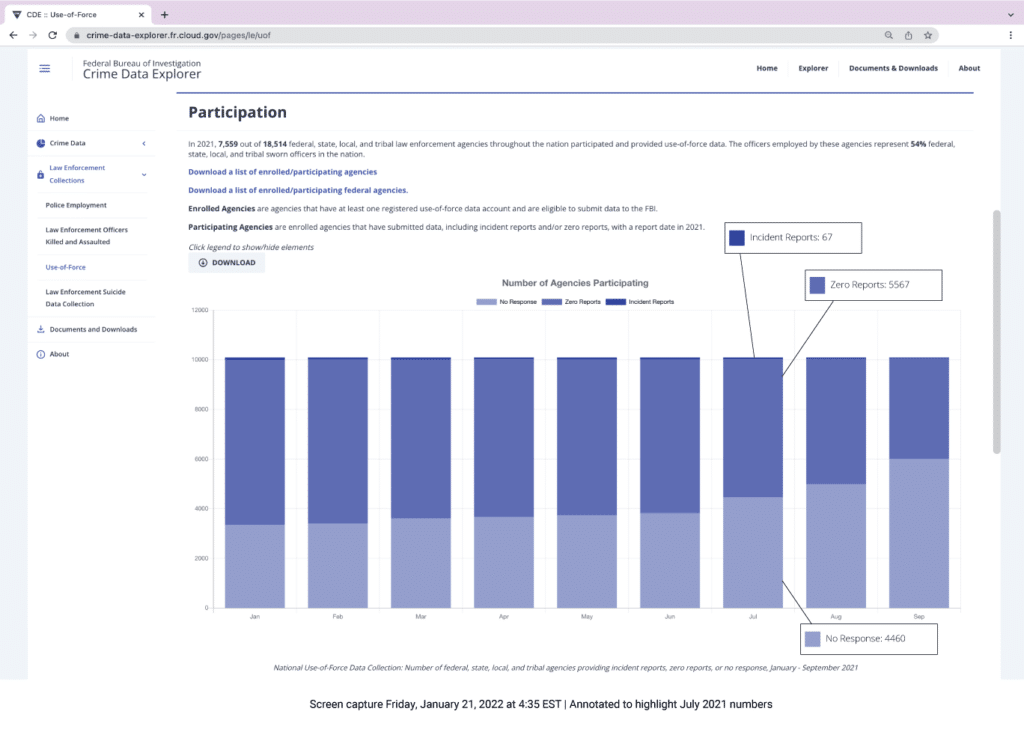7 Things to Know about FBI National Use-of-Force Data Collection
Lori Cox, RMS Compliance Product Manager | 25 January 2022 | 4 minute read

In 2019, the FBI launched its National Use-of-Force Data Program, where federal, state, local, and tribal law enforcement and investigative agencies can voluntarily submit use-of-force data. The goal is to provide a big-picture, national look at use-of-force trends across the country, not to provide insight into individual use-of-force incidents.
The program has been around for a few years, but there are still several misconceptions about the program and how it works.
There are benefits for reporting agencies
Some agencies may be hesitant to share use-of-force data, but agencies who report data to the National Use-of-Force Data Collection Program benefit from:
- Proactively sharing statistics with the community — Stand at the podium with facts, not anecdotes, when meeting with the community
- Nation-wide standardized reporting — Benefit from an apples-to-apples comparison of data between agencies using the same data sets
- Training analysis — Validate agency training to discover what is working, what isn’t working, who needs more training, and how to adjust training to benefit more team members
Agencies must report data — even if there were zero use-of-force incidents
If an agency has zero use-of-force incidents in a month, it must submit the zero incident data to the FBI. This requirement may initially seem counterintuitive, but according to the FBI Crime Explorer FAQ (link opens as PDF), this step is to “confirm no use-of-force incident occurred.”
Tools can simplify the reporting process
Mark43 Use of Force Reporting is an easy-to-use data aggregation tool that enables agencies to track and monitor use-of-force events. Using the configurable tool, agencies can quickly write use-of-force reports, track reports through a multi-level approval process, and export the data in an FBI-compliant digital format for quick upload into the National Use-of-Force Data Collection program.
The ability to export files in an FBI-compliant digital format is crucial because manually completing each data field is cumbersome and time-consuming. Learn more about the easy-to-use tool from the Mark43 Use of Force Reporting fact sheet (opens as PDF).
Without tools, it takes about 38 minutes to report an incident
To properly report national trends, the program collects a minimum of 27 different pieces of data per use-of-force event, including: 12 general data points about the incident, eight data points about suspects involved, and seven data points about each law enforcement official involved. The collection and validation of this data can take a significant amount of time if done by hand. Data must first be collected and validated, and then incident data can be individually submitted to the program.
Using the FBI’s use-of-force web application interface, it takes approximately 38 minutes per incident to report use-of-force incidents to the program. With the right reporting tool, agencies can easily leverage the bulk submission feature and drastically reduce reporting time.
Anyone can review national- and state-level trends
The most recent use-of-force data is available for public review via the FBI’s Crime Data Explorer, where citizens can also see other crime trends for their state, like types of crime, location of crime, overall violent/non-violent crime trends, etc.
Data can be viewed for the U.S. as a whole or on a state-by-state basis. The data covers the number of incidents, zero incident agencies, and agencies who did not submit any use-of-force data or confirm zero incidents for the month.
Here’s a screenshot of the U.S. data for 2021. On the FBI’s Crime Data Explorer website, users can hover the mouse pointer over a specific data spot to see exact numbers.

Additional data points will be available when the FBI reaches 60 percent and 80 percent national representation benchmarks.
Individual state data looks similar. It’s worth noting only states with at least 40 percent of the sworn officer population represented by reporting agencies have data available. For example, here’s how the use-of-force data appears for the state of New York.

Incident collection data will not appear for states where less than 40 percent of the state law enforcement officials are represented by reporting agencies. Users can see how many agencies are reporting data, what percentage of law enforcement officials are represented by the agencies, and download a list of the state’s enrolled agencies.
Adoption is slow but steady
The U.S. Office of Management and Budget (OMB) measures the program’s success by the percentage of the law enforcement population represented by the agencies submitting data. As of December 2021, agencies representing 57 percent of law enforcement officers were participating in the program according to a Government Accountability Office (GAO).
Expect the program to be around for years
According to the OMB, 60 percent of law enforcement agencies need to report data to the program for it to be considered effective. When the GAO announced participation was at 57 percent, the office warned the program could have its funding pulled if more agencies did not submit data. This announcement led to a temporary increase in coverage surrounding the program.
Despite the initial warning of the December announcement, the existing success of the program and the increase in tools that make reporting easier are evidence the program will meet the OMB’s funding requirements and continue to exist as a useful tool now and in the future.
Looking to simplify your use-of-force reporting? Request a demo and discover how Mark43 Use of Force can support your agency.




